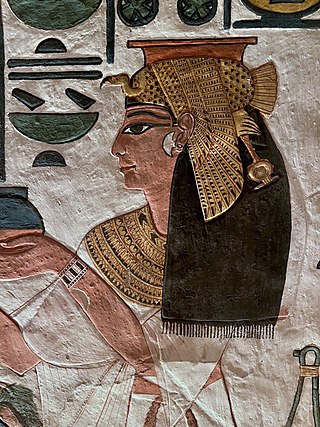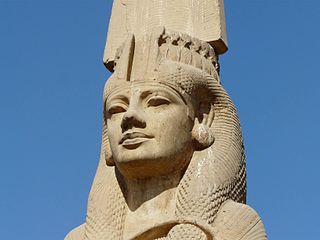Related Research Articles

Nefertari, also known as Nefertari Meritmut, was an Egyptian queen and the first of the Great Royal Wives of Ramesses the Great. She is one of the best known Egyptian queens, among such women as Cleopatra, Nefertiti, and Hatshepsut, and one of the most prominent not known or thought to have reigned in her own right. She was highly educated and able to both read and write hieroglyphs, a very rare skill at the time. She used these skills in her diplomatic work, corresponding with other prominent royals of the time. Her lavishly decorated tomb, QV66, is one of the largest and most spectacular in the Valley of the Queens. Ramesses also constructed a temple for her at Abu Simbel next to his colossal monument there.
A queen consort is the wife of a reigning king, and usually shares her spouse's social rank and status. She holds the feminine equivalent of the king's monarchical titles and may be crowned and anointed, but historically she does not formally share the king's political and military powers, unless on occasion acting as regent.

Mswati III is Ngwenyama (King) of Eswatini and head of the Swazi royal family. He heads Africa’s last absolute monarchy, as he has veto power over all branches of government and is constitutionally immune from prosecution.

Goodwill Zwelithini kaBhekuzulu was the King of the Zulu nation from 1968 to his death in 2021.

Sobhuza II,, was Ngwenyama (King) of Swaziland for 82 years and 254 days, the longest verifiable reign of any monarch in recorded history.

Ahmose-Nefertari was the first Great Royal Wife of the 18th Dynasty of Ancient Egypt. She was a daughter of Seqenenre Tao and Ahhotep I, and royal sister and wife to Ahmose I. Her son Amenhotep I became pharaoh and she may have served as his regent when he was young. Ahmose-Nefertari was deified after her death.

Harem refers to domestic spaces that are reserved for the women of the house in a Muslim family. A harem may house a man's wife or wives, their pre-pubescent male children, unmarried daughters, female domestic servants, and other unmarried female relatives. In the past, harems also enslaved concubines. In former times some harems were guarded by eunuchs who were allowed inside. The structure of the harem and the extent of monogamy or polygyny has varied depending on the family's personalities, socio-economic status, and local customs. Similar institutions have been common in other Mediterranean and Middle Eastern civilizations, especially among royal and upper-class families, and the term is sometimes used in other contexts. In traditional Persian residential architecture the women's quarters were known as andaruni, and in the Indian subcontinent as zenana.

Meritamen was a daughter and later Great Royal Wife of Pharaoh Ramesses the Great.

Great Royal Wife, or alternatively, Chief King's Wife, is the title that was used to refer to the principal wife of the pharaoh of Ancient Egypt, who served many official functions.
The Zulu royal family, also known as the House of Zulu consists of the king of the Zulus, his consorts, and all of his legitimate descendants. The legitimate descendants of all previous kings are also sometimes considered to be members.

The House of Dlamini is the royal house of the Kingdom of Eswatini. Mswati III, as king and Ngwenyama of Eswatini, is the current head of the house of Dlamini. Swazi kings up to the present day are referred to as Ingwenyama and they rule together with the Queen Mother who is called Indlovukati. The Swazi kings, like other Nguni nations, practice polygamy and thus have many wives and children.

Nebettawy(nb.t-t3.wỉ; "Lady of the Two Lands") was an ancient Egyptian princess and queen, the fifth daughter and one of the eight Great Royal Wives of Pharaoh Ramesses II.

The Eighteenth Dynasty of Egypt is classified as the first dynasty of the New Kingdom of Egypt, the era in which ancient Egypt achieved the peak of its power. The Eighteenth Dynasty spanned the period from 1550/1549 to 1292 BC. This dynasty is also known as the Thutmoside Dynasty) for the four pharaohs named Thutmose.

In Eswatini, no king can appoint his successor. Instead, the Liqoqo, an independent traditional council, decides which of the wives shall be "Great Wife" and "Indlovukazi". The son of this "Great Wife" will automatically become the next king.

Women in ancient Egypt had some special rights other women did not have in other comparable societies. They could own property and were, at court, legally equal to men. However, Ancient Egypt was a patriarchal society dominated by men. Only a few women are known to have important positions in administration, though there were female rulers and even female pharaohs. Women at the royal court gained their positions by relationship to male kings.

Princess Zenani Mandela-Dlamini is a South African diplomat and traditional aristocrat. She is the sister-in-law of the King of eSwatini, Mswati III, and the daughter of Nelson Mandela and his former wife, Winnie Mandela.

Sibonelo Mngometulu, known as Inkhosikati LaMbikiza, is the third and senior wife of King Mswati III of Eswatini. Sibonelo married Mswati III in 1986, becoming the first wife he personally chose to marry, following two ceremonious marriages. She is the mother of Princess Sikhanyiso Dlamini and Prince Lindani Dlamini.
Shiyiwe Mantfombi Dlamini Zulu was the queen consort of the Zulu nation from 1977 to 2021 as the Great Wife to King Goodwill Zwelithini. She served as the queen regent from March 2021 to April 2021.
Misuzulu Sinqobile kaZwelithini is the reigning King of the Zulu nation. Misuzulu is the third-oldest surviving son of King Goodwill Zwelithini kaBhekuzulu, and Great Wife, Queen Mantfombi Dlamini Zulu. Misuzulu became heir presumptive after the death of his father on 12 March 2021.
Polygamy in Africa has existed throughout the history of Africa. Polygamy, particularly polygyny, is a highly valued social institution in Africa. Polygamy is a marriage between a man or woman and their multiple spouses. Polygyny is a marriage between a man and multiple wives. Polyandry is a marriage between a woman and multiple husbands. A common expectation for African kings in African societies is for African kings to symbolically unify his kingdom and the society through partaking in polygamous marriages with wives from a broad range of clans within the society. By doing so, the king reduces the chance of dissident and rival forces developing and rising against him.
References
- ↑ "Veranda post of enthroned king and senior wife". artsandculture.google.com. Retrieved June 13, 2023.
- ↑ "King Zwelithini: Who is Mantfombi MaDlamini Zulu?". thesouthafrican.com. Retrieved June 13, 2023.
- ↑ Shaw, Garry J. The Pharaoh, Life at Court and on Campaign, Thames and Hudson, 2012, p. 48, 91-94.
- ↑ Cameron, Averil; Kuhrt, Amélie. Images of Women in Antiquity, 1993, Routledge, ISBN 0-415-09095-4
- ↑ "Definition of GOODWIFE". www.merriam-webster.com. Retrieved 2024-04-15.
- ↑ "Harem | History, Gender Roles & Social Structures | Britannica". www.britannica.com. 2024-02-28. Retrieved 2024-04-15.
- ↑ Schiller, L. D. (1990). The Royal Women of Buganda. The International Journal of African Historical Studies, 23(3), 455–473. https://doi.org/10.2307/219599
- ↑ "The Queen Mother in the Kingdom of Kush: Status, Power and Cultic Role (PDF)". academia.edu. Retrieved June 13, 2023.
- ↑ "Who was Nefertari, the most famous ancient Egyptian queen?". History Skills. Retrieved 2024-04-15.
- ↑ Conroy, William (2023-11-07). "Queen Nefertari: Ancient Egypt's Royal Wife | AncientPedia". ancientpedia.com. Retrieved 2024-04-15.
- ↑ Archaeology, Current World (2007-05-07). "Gurob, Unlocking a Royal Harem". World Archaeology. Retrieved 2024-04-15.
- ↑ "The Big Question: What is the history of polygamy and how serious a problem is it in Africa?". independent.co.uk. Retrieved June 13, 2023.
- ↑ "Arabic teacher drags wife to court for disrespecting senior wife". tribuneonlineng.com. Retrieved June 16, 2023.
- ↑ Isabel Moodley. "The Customary Law of Intestate Succession" (PDF). Retrieved June 16, 2023.